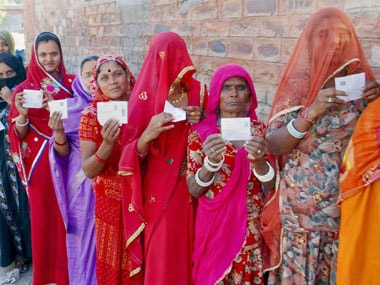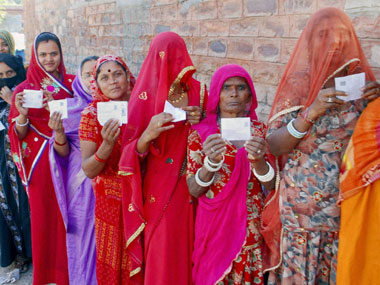Jaipur: Voter enthusiasm was a bit damp during the second phase of polling in Rajasthan compared to the first, but the jump in average polling in the state this general election, compared to 2009, is something that would make the Election Commission happy. The first phase of polls in 20 constituencies of the total 25 on 17 April registered 63.5 percent voting. There was a minor dip today with polling at 56.8 percent. In 2009, the voting percentage stood at 48.46 and it has gone up by almost 15 percent this time. Was it the Modi wave, the anti-Congress tsunami or tremendous youth participation? The jury is out on the reason behind the impressive leap. However, the general feeling is that it is a combination of all three. The BJP, it appears, continues where it left off in the assembly elections, four months ago. It lost none of the momentum after its resounding victory in December and it showed in its aggressive campaigning. [caption id=“attachment_1260755” align=“alignleft” width=“380”]  File photo of women waiting to cast their votes in Rajasthan. PTI[/caption] The battered and bruised Congress still looked jaded from the blow it had received. A low turnout would have reflected a drop in public enthusiasm. That has not been the case. The five constituencies that went to polls today are Alwar, Tonk-Sawaimadhopur, Bharatpur, Dausa and Dholpur-Karauli. At 63 percent turnout, Alwar recorded the highest poling in this phase - a jump of about eight percent compared to 2009. Dausa registered 61 percent polling and Bharatpur 53 percent. In Tonk-Sawaimadhopur from where cricketer Mohammed Azharuddin contesting on a Congress ticket is facing another outsider – BJP’s Sukhbir Singh Jaunapuriya, the turnout was 53 percent, marginally less compared to 53.16 percent in 2009. At Dholpur Karauli reserved seat the polling was 53 percent compared to 37.47 percent in the previous election. In 2009, the Congress had formed a minority government under Ashok Gehlot, yet it performed well in the parliamentary polls, winning 20 out of the 25 seats with the BJP securing only four. “Thus with the BJP in power, the situation is the same, but in BJP’s favour. This has been a trend in the state since 2003. In 2003, the BJP was in power and it won 20 seats. The hangover effect is crucial in the state,” says political analyst Om Saini. A study of the voting trend since 1998 reveals that if the Lok Sabha elections are held within a year of the assembly elections, the ruling party in the state manages to get 10 to 14 percent more votes. It could only translate into a thumping victory for the party in power.
Voting trends since 1998 show that if the LS polls are held within a year of the assembly elections, the ruling party manages to get more votes.
Advertisement
End of Article


)
)
)
)
)
)
)
)
)



